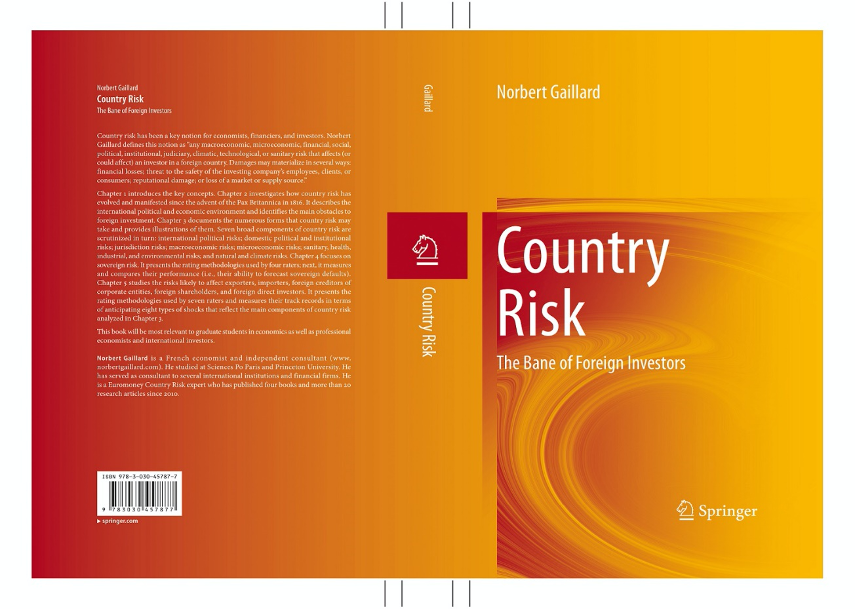Country Risk: The Bane of Foreign Investors
by Norbert Gaillard, economist and independent consultant.
This blog article is based on the book Country Risk: The Bane of Foreign Investors, Cham, Springer, July 2020, 259 pages.
—
Country risk includes, ‘any macroeconomic, microeconomic, financial, social, political, institutional, judiciary, climatic, technological, or sanitary risk that affects (or could affect) an investor in a foreign country. Damages may materialize in several ways: financial losses; threat to the safety of the investing company’s employees, clients, or consumers; reputational damage, or loss of a market or supply source’ (Gaillard 2020).

Although it was not until the mid-1970s that the concept of country risk began to permeate the economic literature and media, the obstacles listed above have challenged international investors for many years.
One of the most important threats was certainly expropriation (or nationalization) risk, which materialized dramatically with the advent of WWI. In the first weeks of war, Austria-Hungary, France, Germany, Great Britain, and Russia enacted legislation that prohibited trade with the enemy and sanctioned the confiscation and even liquidation of the businesses owned by enemy aliens located on their territory (Caglioti 2014). In doing so, combatant nations violated the principle of ‘immunity of private enemy property’ established by the Hague Conventions of 1899 and 1907.
The most striking nationalization episode followed the Soviet Revolution of 1917, when the communists seized all property belonging to foreigners. Other significant expropriations occurred in Bolivia and Mexico in 1937 and 1938, respectively; they affected American and British oil companies (Maurer 2013).
World War II led to the widespread confiscation of enemy assets, which further undermined the sanctity of foreign private property. During the Cold War, expropriation risk remained a major concern among international investors (Figure 1). Nationalizations were driven by three factors: interventionist or even socialist policies, the extensive interpretation of every State’s right to exploit its natural resources and, finally, idiosyncratic political motives (e.g., Iran in 1951 and 1979–1980; Indonesia in the early 1960s).
How can we explain the spectacular fall in the number of expropriation acts observed in the 1980s and 1990s? In fact, the debt crisis of the 1980s obliged most developing and emerging countries to adopt market-friendly policies (for example, legal security for property rights, privatization of state-owned enterprises, and the liberalization of trade and finance). These policies were soon encapsulated in the term ‘Washington Consensus (Williamson 1990).

Source: Based on Gaillard (2020).
Nationalization risk was crucial in the history of country risk. The expropriation acts announced by Fidel Castro in 1959–1960 served as a catalyst and led to the development of political risk and country risk assessment tools.
In my book, I identify several generations of indicators. The first generation includes the risk indicators developed in the 1960s by consulting firms, such as Business International and Business Environmental Risk Index (BERI). The second generation is composed of the external country risk assessors that emerged shortly before the globalization years – namely, Euromoney and International Country Risk Guide. The third generation is represented by export credit agencies. The fourth generation comprises what I call ‘neoliberal indicators’. Launched in the mid-1990s, the indices of the Heritage Foundation and the Fraser Institute put considerable emphasis on economic freedom. The fifth generation, which gained influence in the 2000s, scrutinizes competitiveness; the Global Competitiveness Reports published by the World Economic Forum are emblematic of this last generation.
I analyse how well these risk indicators anticipated eight types of shocks: major episodes of international political violence, major episodes of domestic political violence, expropriation acts, high-inflation peaks, deep economic depressions, significant restrictions on capital flows, sovereign debt crises, and exceptional natural disasters. The accuracy of these ratings reveals some performance gaps. Euromoney and the World Economic Forum’s Global Competitiveness Index (GCI) outperform their counterparts. Euromoney’s ‘risk-free’ rating category and the GCI’s top-ranked group (that is, the top 25 per cent) are especially reliable. The Fraser Institute’s Economic Freedom of the World index is less accurate than other indicators owing to the high proportion of ‘crisis countries’ in its top ratings and rankings.
—
To contact the author: norbertgaillard@aol.com
References
Caglioti, D. L. (2014), “Property Rights and Economic Nationalism,” in U. Daniel et al. (Eds.), 1914–1918 Online International Encyclopedia of the First World War, Freie Universität Berlin.
Gaillard, N. (2020), Country Risk: The Bane of Foreign Investors, Springer.
Maurer, N. (2013), The Empire Trap – The Rise and Fall of U.S. Intervention to Protect American Property Overseas, 1893–2013, Princeton University Press.
Williamson, J. (1990), “What Washington Means by Policy Reform,” in J. Williamson (Ed.), Latin American Adjustment: How Much Has Happened?, Peterson Institute for International Economics.

